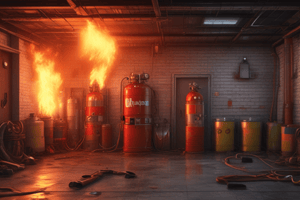Podcast
Questions and Answers
What is the potential hazard of installing solar panels on a roof?
What is the potential hazard of installing solar panels on a roof?
- They make roof ventilation difficult
- They add substantial weight to the roof
- They accelerate structural failure
- They create a potential ignition source and electrical shock hazard (correct)
What is the effect of green roofs on roof ventilation?
What is the effect of green roofs on roof ventilation?
- They have no effect on roof ventilation
- They improve roof ventilation
- They make roof ventilation difficult (correct)
- They accelerate structural failure
What is the risk associated with lightweight building materials?
What is the risk associated with lightweight building materials?
- They have no effect on structural stability
- They create a potential ignition source and electrical shock hazard
- They make roof ventilation difficult
- They accelerate structural failure (correct)
What is the difficulty in fighting basement fires?
What is the difficulty in fighting basement fires?
What is the recommended tactic for softening the target in a basement fire?
What is the recommended tactic for softening the target in a basement fire?
What is the worst-case scenario in a basement fire?
What is the worst-case scenario in a basement fire?
What is the effect of ventilation on ventilation-limited fires?
What is the effect of ventilation on ventilation-limited fires?
What is the importance of checking for heat and controlling doors in a basement fire?
What is the importance of checking for heat and controlling doors in a basement fire?
What is the concern when firefighters work on the floor above a basement fire?
What is the concern when firefighters work on the floor above a basement fire?
What is the result of venting in the absence of effective suppression during UL test fires?
What is the result of venting in the absence of effective suppression during UL test fires?
What is the concern with standard measures used to test floor stability?
What is the concern with standard measures used to test floor stability?
What is the result of NIST's research using fire models after a fatal fire?
What is the result of NIST's research using fire models after a fatal fire?
Flashcards are hidden until you start studying
Study Notes
- Green construction is becoming more prevalent with the installation of green roofs and solar panels.
- Green roofs make roof ventilation difficult and add substantial weight to the roof.
- Solar panels create a potential ignition source and electrical shock hazard.
- Lightweight building materials generally accelerate structural failure.
- Changes in the density and dimensions of newer lumber have compounded the problem of structural failure.
- Basement fires have always presented a difficult and dangerous problem.
- Advancing a hose line down the interior stairway from the first floor to the basement is a difficult and dangerous tactic.
- Softening the target by applying water through a window or from the exterior through a grade-level basement entrance may provide the cooling effect needed to allow firefighters to enter the basement.
- Firefighters are at significant risk of injury or death when fighting fires in basements or floors below grade level.
- Fire departments should conduct a complete 360 size-up to locate possible exterior attack positions and reassess fire conditions prior to conducting interior operations.
- The text discusses the dangers of fighting fires in basements.
- Response to a basement fire in Ohio was delayed due to difficulty locating the building.
- Upon arrival, moderate smoke was visible and all occupants were out of the house.
- Two firefighters entered the basement with a hose line and encountered heat and a glow to their left.
- Collapse times for various floor support systems were studied in a UL report in 2012.
- Collapse of all floor systems tested would occur either before or during fire unit response time.
- Basement fires range from small fires to large industrial fires with extra-hazard fuel loads.
- Venting in the absence of effective suppression had a negative effect on structural stability during UL test fires.
- Standard measures used to test floor stability are late indicators and not entirely reliable.
- Falling through the first floor into a well-involved fire in the basement is the worst-case scenario.
- Heat and gases from a fire travel upward and then horizontally.
- Ventilation-limited fires intensify rapidly when air is introduced.
- Opening doors in a basement fire allows heat, smoke, and toxic gases to travel upward and out.
- Checking for heat and controlling doors is crucial when opening doors to basements.
- After a fatal fire, NIST conducted research using fire models to determine heat conditions.
- The model showed a distinct flow path from the basement up the stairway and out the front door.
- Temperatures on the basement stairway were as high as 1508°F (820°C).
- Ceiling temperatures on the first floor were in the same range as in the stairway.
- Floor collapse is a major concern when combating a basement fire.
- Firefighters working on the floor above could fall through the floor into the fire below.
Studying That Suits You
Use AI to generate personalized quizzes and flashcards to suit your learning preferences.




